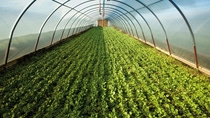News & Media
Greenhouses need sun protection too
The light stabilizer Tinuvin® XT 200 from BASF prolongs the service life of films in agriculture.

A greenhouse offers plants optimal growing conditions: it protects them against wind and weather while still admitting the light they need to grow. With ideal temperatures and targeted watering, plants flourish at a rate that would be unthinkable in an open field. So it comes as no surprise that a large proportion of our vegetables, but also many varieties of soft fruit or cut flowers, are now grown in greenhouses that produce many times the normal yield thanks to the considerably prolonged growing season and the rapid growth rates.
Increasingly, conventional glass greenhouses are being replaced by greenhouses consisting of simple frames covered with plastic films and combining lower cost with greater flexibility. 900,000 metric tons of these greenhouse films (usually made from polyethylene, PE for short) were produced worldwide in 2009. Enough to cover about 800,000 hectares, or roughly the entire surface area of the Greek island of Crete, with greenhouses. To make these films resistant to intense sunlight, light stabilizers – of which BASF offers an entire product range under the trade name Tinuvin – are added to the material.
The light stabilizers protect the plastic against its worst enemy: weathering from the sun's intense UV radiation and the heat developing at the contact points with the metallic greenhouse frame. In fact, plastic films can become brittle and dull within a few weeks, an effect further intensified by the use of some agrochemicals. Unless, of course, they are protected by light stabilizers.
Besides UV absorbers which directly intercept the harmful radiation in the same way as a sun cream, especially compounds of the sterically hindered amine light stabilizer (HALS) class are important for protecting greenhouse films. These HALS slow down not only the weathering process due to UV radiation, but also the degradation of the material caused by heat and chemicals. Because all these trigger factors lead to the formation of free radicals, extremely reactive molecules which destroy the long molecule chains of the polyethylene: the film loses its stretch properties, becomes brittle and decays.

The hindered amines of HALS compounds act in a similar manner to the human body protecting itself with antioxidants like vitamin C against free radicals: they intercept the radical and make it harmless. How long this protective effect lasts can be controlled by selecting a specific stabilizer additive: with the already longer established Tinuvin® NORTM 371, greenhouse films withstand weathering for at least three to four years; the latest member of the product family, Tinuvin® XT 200, offers a service life of at least 24 months at a lower cost.
"In many situations, a longer service life is not necessary anyway, for example when deposits of dust keep out too much light after only one season," explains Davide Alvisi of the BASF Development Center in Bologna. Moreover, the stress affecting the films, resulting mainly from the factors UV radiation, heat and agrochemicals, often varies considerably depending on the location and the type of cultivation. While it tends to be rather moderate in Central Europe, greenhouse films in Southern Europe or North Africa are often exposed to critical levels of wear and tear. The trend towards ecological farming is also imposing new demands. Because although the sulfur compounds approved as agricultural products to prevent and combat fungal diseases are ecologically safe, chemically they readily deactivate the light stabilizers and accelerate their breakdown, explains Alvisi. "This is why BASF developed these two Tinuvin stabilizers for greenhouse films – based on NOR technology – which are particularly resistant to sulfur compounds and other agrochemicals."
The new stabilizer Tinuvin XT 200 has successfully completed a six year development phase. Extensive field trials in Spain, China, Mexico and elsewhere also demonstrated the hoped-for resistance to high temperatures and the acidic chemicals that can accumulate at the contact points of film and metal or wooden frames. Laurent Burget, BASF Marketing Manager for Plastic Additives can also document positive results from lots of farmers in southern countries: "With the light stabilizer Tinuvin XT 200, a service life of 24 months was still achieved for the greenhouse films – even under the harshest conditions of the intensive solar radiation and high temperatures which are common in the South. The stabilizer is also highly efficient against agrochemicals. This stability will enable the farmers to produce profitably throughout the entire growing season.“ The new light, heat and sulfur protection for greenhouse films fills the gap between the extremely long-lasting films with Tinuvin NOR 371 and the shorter-term films designed for one year's use. The film manufacturers mix the granules that contain the light stabilizer with the carrier material PE to produce the actual film.

The Info Box
How a greenhouse works
A greenhouse is nothing but a trap for the sun's radiation energy, which penetrates through the transparent walls of the greenhouse. As soon as the sunlight reaches the darker surfaces of the plant leaves or the soil, it is partially absorbed and converted into heat and partially reflected. Because the long-wave thermal radiation cannot escape through the greenhouse walls as quickly as short-wave radiation, however, the heat builds up inside the greenhouse and the temperatures rise. To prevent the greenhouse from overheating in summer, the excess heat can be released by selective ventilation or other cooling systems. In physical terms it makes no difference whether the walls of a greenhouse are made of glass or transparent plastic film. But using plastic films is much easier and more flexible.
Mulch films – the greenhouse for the roots
Greenhouses are not the only application for agricultural films made especially durable by the addition of light stabilizers. Besides silage films under which corn, grass or other cattle food is preserved by excluding air, or extra-stretch films for packaging bales of straw, so-called mulch films are also required. These are usually black films which are used on about 4,000 hectares of arable land in Germany alone, and cover the soil around field-grown crops such as various vegetable varieties, strawberries or sweet corn. Under these conditions, no weeds can grow, the moisture is retained more effectively in the soil and fertilizer is not leached out so quickly. Above all, however, in the cool spring season they raise the soil temperature by at least two degrees Celsius and function as a mini greenhouse for the roots, allowing much earlier planting out in vegetable plots.
Further applications for light stabilizers
Not only agricultural films have to withstand the degradation caused by the sun's UV radiation. Tinuvin light stabilizers are also used in the coating industry (e. g. in the automotive industry) to protect the coating system from early failure or pigment discoloration caused by UV radiation. They are also used for adhesives and sealants in the construction industry, e. g. in window sealings and for the production of photovoltaic cells. Light stabilizers retard the degradation of the materials and therefore their embrittlement. Hence they provide for a longer life time of these products.

